HNLMS Koning der Nederlanden was an iron-hulled ironclad “ramtorenschip”, a turret ram ship built at Rijkswerf, Amsterdam in 1871-77. She was the largest ever of the Dutch Navy and remains so for that era, until the start of the century. She was a 5400t, 12 knots, Barque-rigged armoured ship protected by up to 305 mm (12 inches) turrets and 200 mm or 8 inches belt, and had two twin turrets with 11-inch (279 mm) guns. She also had a very long career. Obsolete, she was converted to a barracks ship in the late 1890s, stationed in Surabaya, Dutch East Indies. When the Japanese attacked the area in early 1942, Koning der Nederlanden was still there. She was scuttled in Surabaya on 2 March 1942 in what was the outcome of the Battle of Java, to prevent capture by the Japanese, even if it’s dubious what she could have been used for at this point.

Engraving of the ship as built, 1879.
HNLMS “KDN” (the abbreviated form), was an attempt to design a sea-going armoured ship, in order to take a more active stance in coastal defence, notably to be able to intervene in the Baltic and Noth sea, as well as to operate from the Dutch East Indies. The navy began to modernize the fleet with monitors in the 1860s, and from 1867, the Rijkswerf in Amsterdam was the first shipyard capable of delivering large and modern all-steel warships. In the 1890s saw a range of protected cruisers and coastal defense ships introduced enabling consirerable more leeway in flexivility to the Royal Netherlands Navy in 1905. However in 1870, the fleet still had the broadside ironclads De Ruyter (1863) and Turret ship Prins H. der Netherlands (1866), reinforced by the turrets rams of the Buffel class (1868), Skorpioen class (1868), Heiligerlee class (1868) and Bloedhond class (1869) as well as the Adder class Monitors (1870).
All these ships were essentially defensive and for homeland waters. They were ill-suite to long range operations and if needed could not cross on open seas to reinforce the Empire, wether it was the Western or Eastern Indies. For this a proper sea-going ship was needed. Thus, efforts were made to remp up the capabilities of the Rijkwerft yard in order to built such vessel, which design was ready in 1970, inspired by Royal Navy turret ironclads of that era.
Construction was approved at the diet, at a cost later estimated to 3,220,170 florins. She was laid down on 31 December 1871 and launched on 28 October 1874, then Commissioned on 16 February 1877. Six years were a long construction time, but she was way more complex than the previous monitors of the netherlands Navy.
Design of Koning der Nederlanden
Hull and general design

Full cutaway and plans from the national Dutch naval museum
HNLMS Koning der Nederlanden was the largest ship ever built for the Dutch Navy in the 19th century. She had a pronounced ram protruding 1.22 meters (4 ft), shaped like British rams, with a progressive “S” shape instead of a pointy end like French or Italian ships.
This iron-hulled ironclad ram ship measured between perpendicular 268 feet 4 inches (81.8 m) for a beam of 49 feet 10 inches (15.2 m), and draught of 19 feet 3 inches (5.87 m). She displaced 5,400 tonnes (5,300 long tons) standard. She had three masts,
She carried a crew of 256 officers and men.
Despite her much taller freeboard compared to previous monitors, her two gun turrets were still only 3.3 meters (10 ft 10 in) above the waterline, albeit this freeboard could be increased by hinged bulwarks, just lowered when it was time to fire. The turrets had hydraulic machinery to rotate them, similar to the Coles System. They were located fore and aft of a central structure supporting both the bridge and three small funnels. Apart her three masts barque rig, she also had six service boats located on deck and under davits along the side between turrets and aft.
Protection
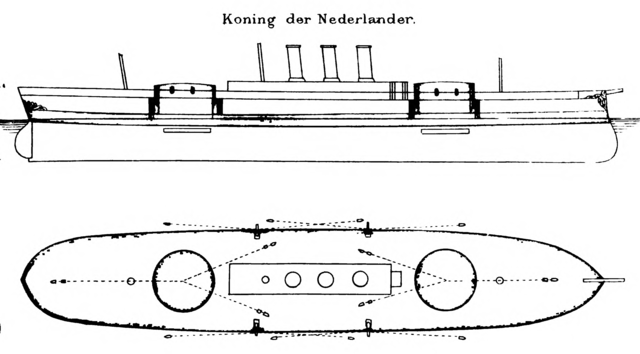
Koning der Nederlanden was fitted with a a complete waterline belt made of wrought iron, British cast, and 200 millimeters (7.9 in) thick amidships. It was tapered down to 150 millimeters (5.9 in) at the bow and stern, as customary for British designs at the time. Each gun turret and its base however were protected by 230-millimeter (9.1 in) armor plates but the front piece around the gun ports was even thicker at 305 millimeters (12 in). The deck was however completely unarmored. There was no underwater compartmentation either but the standard machinery separation bulkheads.
Powerplant of Koning der Nederlanden
She had two screw propellers, bronze, four bladed, 4.876 meter (16.0 ft) in diameter, driven by two compound steam engines built by Penn and Sons in UK. These steam engines of the HRCR type were powered by seven boilers. These engines produced 4,630 indicated horsepower (3,450 kW), enough for a top speed of 11.95 knots (22.13 km/h; 13.75 mph) achieved during her sea trials on 26 July 1877. For autonomy she carried 620 long tons (630 t) of coal. The seven boilers were truncated into three funnels close together. They were surrounded by air intake and vents pipes. The ship was barque-rigged with three masts as said above, probably with steam-drive capstans reducing the crew’s efforts and for a total of 847 square meters (9,120 sq ft) giving her unlimited range. On steam alone,
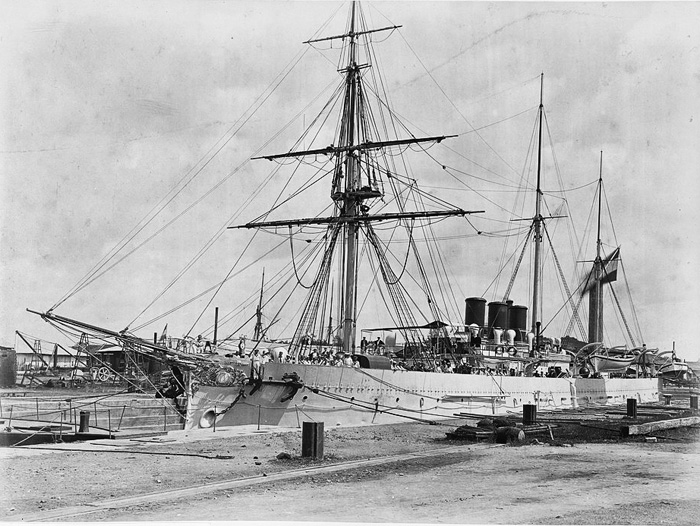
Armament of Koning der Nederlanden
2×2 Armstrong 11-inch (279 mm) RML
Like many turret ships of her age, KDN had one turret fore and aft, of the cheesebox type, and housing British purchased ordnance, two Armstrong 11-inch (279 mm) rifled muzzle-loading guns. Their barrels protruded from the turret faces which could be closed in heavy weather if the guns were recoiled far enough. Each gun weighed 25.4 long tons (25.8 t). To fire, the side bulwards needed to be folded down in order to free their lowest angles.
4x Krupp BLR
This was supplemented by Four 120-millimeter (4.7 in) Krupp breech-loading guns, so German-bought, mounted on the upper deck, in the inner perimeter defined by the turrets and around the central structure. They were not sponsoned and had a limited arc of fire, being protected by bulkwarks.
6x Hotchkiss Guns
This was completed by six 37 mm (1.5 in) Hotchkiss 5-barrel revolving guns. For a better arc they were not locatred on deck, hidden by bulwarks but instead moved on the structure’s roof amidships. They fired a 1.1 lb (0.50 kg) HE shell at a muzzle velocity of 2,000 ft/s (610 m/s) and had a range about 3,500 yards (3,200 m). Rate of fire was about 30 rounds per minute. Originally she was to carry spar torpedoes, either carried herself as an addition to her ram, probably on two spars forward, but they were removed shortly after completion. There was no steam cutter on board to carry them, but launching a landing part was always possible.
⚙ specifications Koning der Nederlanden |
|
| Displacement | 5,400 metric tons (5,300 long tons) |
| Dimensions | 268 ft 4 in x 49 ft 10 in x 19 ft 3 in (81.8 x 15.2 x 5.9 m) |
| Propulsion | 2 shafts, Compound steam engines, 7 boilers: 4,630 ihp (3,450 kW), Barque-rigged |
| Speed | 12 knots (22 km/h; 14 mph) |
| Range | Unknown, unlimited with sail. |
| Armament | 2×2 11-inch (279 mm) MLR, 4× 120 mm (5 in) BLR, 6× 37-mmm (1.5 in) Hotchkiss |
| Protection | Belt 150–200 mm (6–8 in), Gun turrets 230–305 mm (9–12 in) |
| Crew | 256 |
Career of HNLMS Koning der Nederlanden
Koning der Nederlanden was laid down at the Rijkswerf in Amsterdam on 31 December 1871. She was launched on 20 October 1874 and commissioned on 16 February 1877. The ship was designed by B.J. Tideman and renamed from Matador to Koning der Nederlanden during construction. In the autumn of 1876 the ship was transferred through the newly built North Sea Canal to the naval yard Willemsoord in Den Helder. In September 1877 she carried out see trials on the North and Baltic Sea. She left the Netherlands on 3 March 1878 for the Dutch East Indies where she arrived in Aceh on 6 may that year.
From there she steamed to Batavia where she arrived in June 1878 and was repaired at Surabaya from August until November that year. At the end of the year she was stationed at Batavia and served in the Auxiliary squadron. In May and June 1880 she made a trip to the Timor Archipelago to show the Dutch flag. From March till August 1881 Koning der Nederlanden was stationed at Cirebon. She was there to support measures taken by the civil government to counter the in- and export of cattle in the region. In late January 1882 she was again sent to Cirebon due to the outbreak of cholera. The ship was recalled after a few weeks and send to Riau for practice.
In April and July 1883 she practiced respectively along the north coast of Java and the Sunda Strait. On 1 August she replaced Zeeland as guard ship at Batavia. After an outbreak of cholera on board later that year the crew disinfected the ship in late September. Koning der Nederlanden was since December 1883 in Surabaya for repairs to her boilers. The boilers were later replaced in 1885 at Surabaya.[14] In April 1887 she was sent together with Prins Hendrik der Nederlanden to Makassar for a three-month practice. From 25 June 1889 until 1 January 1893 she was attached to the naval force stationed on the north coast of Aceh. After that she served as station ship in Olehleh, Aceh until 7 February 1895.
The 37-millimeter guns were replaced by two quick-firing, 75-millimeter (3.0 in) guns and four 37-millimeter quick-firers by 1890. The ship decommissioned on 1 April 1895 and began her conversion to an accommodation and guard ship at Surabaya Dockyard in August 1896. She retained all four of her 120-millimeter and two of her 37-millimeter guns when she recommissioned on 1 December 1899.
From 1920 till 1922 she served as debarkment and accommodation ship for the Submarine Service. She was set on fire in Surabaya and then scuttled to prevent her capture by the Japanese during World War II on 2 March 1942.
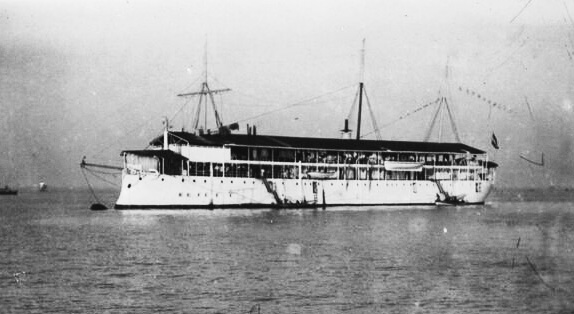

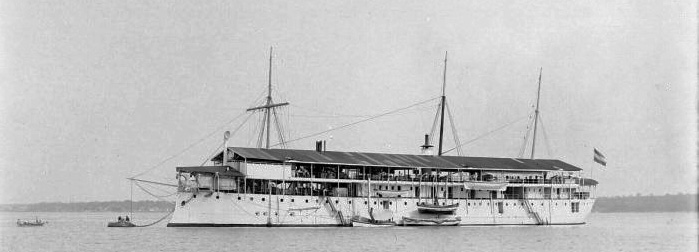
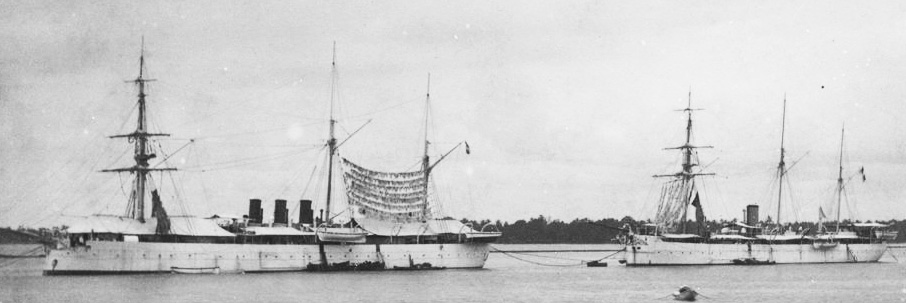
Read More/Src
Links
https://en.wikipedia.org/wiki/HNLMS_Koning_der_Nederlanden
model at maritiemdigitaal.nl
https://www.maritiemdigitaal.nl/index.cfm?event=search.getadvancedsearch&shipname=Koning+der+Nederlanden%2C+Zr.Ms.
https://commons.wikimedia.org/wiki/Category:Zr.Ms._Koning_der_Nederlanden_(ship,_1877)#mw-subcategories
https://www.navypedia.org/ships/netherlands/nl_bb.htm
https://www.history.navy.mil/research/histories/ship-histories/danfs/k/koningen-der-nederlanden.html
https://www.maritiemdigitaal.nl/index.cfm?event=search.getdetail&id=103000205
http://navalhistory.flixco.info/H/284135×53056/8330/a0.htm




 Latest Facebook Entry -
Latest Facebook Entry -  X(Tweeter) Naval Encyclopedia's deck archive
X(Tweeter) Naval Encyclopedia's deck archive Instagram (@navalencyc)
Instagram (@navalencyc)





 French Navy
French Navy Royal Navy
Royal Navy Russian Navy
Russian Navy Armada Espanola
Armada Espanola Austrian Navy
Austrian Navy K.u.K. Kriegsmarine
K.u.K. Kriegsmarine Dansk Marine
Dansk Marine Nautiko Hellenon
Nautiko Hellenon Koninklije Marine 1870
Koninklije Marine 1870 Marinha do Brasil
Marinha do Brasil Osmanlı Donanması
Osmanlı Donanması Marina Do Peru
Marina Do Peru Marinha do Portugal
Marinha do Portugal Regia Marina 1870
Regia Marina 1870 Nihhon Kaigun 1870
Nihhon Kaigun 1870 Preußische Marine 1870
Preußische Marine 1870 Russkiy Flot 1870
Russkiy Flot 1870 Svenska marinen
Svenska marinen Søværnet
Søværnet Union Navy
Union Navy Confederate Navy
Confederate Navy Armada de Argentina
Armada de Argentina Imperial Chinese Navy
Imperial Chinese Navy Marinha do Portugal
Marinha do Portugal Mexico
Mexico Kaiserliche Marine
Kaiserliche Marine 1898 US Navy
1898 US Navy Sovietskiy Flot
Sovietskiy Flot Royal Canadian Navy
Royal Canadian Navy Royal Australian Navy
Royal Australian Navy RNZN Fleet
RNZN Fleet Chinese Navy 1937
Chinese Navy 1937 Kriegsmarine
Kriegsmarine Chilean Navy
Chilean Navy Danish Navy
Danish Navy Finnish Navy
Finnish Navy Hellenic Navy
Hellenic Navy Polish Navy
Polish Navy Romanian Navy
Romanian Navy Turkish Navy
Turkish Navy Royal Yugoslav Navy
Royal Yugoslav Navy Royal Thai Navy
Royal Thai Navy Minor Navies
Minor Navies Albania
Albania Austria
Austria Belgium
Belgium Columbia
Columbia Costa Rica
Costa Rica Cuba
Cuba Czechoslovakia
Czechoslovakia Dominican Republic
Dominican Republic Haiti
Haiti Hungary
Hungary Honduras
Honduras Estonia
Estonia Iceland
Iceland Eire
Eire Equador
Equador Iran
Iran Iraq
Iraq Latvia
Latvia Liberia
Liberia Lithuania
Lithuania Mandchukuo
Mandchukuo Morocco
Morocco Nicaragua
Nicaragua Persia
Persia San Salvador
San Salvador Sarawak
Sarawak Uruguay
Uruguay Venezuela
Venezuela Zanzibar
Zanzibar Warsaw Pact Navies
Warsaw Pact Navies Bulgaria
Bulgaria Hungary
Hungary

 Bundesmarine
Bundesmarine Dutch Navy
Dutch Navy Hellenic Navy
Hellenic Navy Marina Militare
Marina Militare Yugoslav Navy
Yugoslav Navy Chinese Navy
Chinese Navy Indian Navy
Indian Navy Indonesian Navy
Indonesian Navy JMSDF
JMSDF North Korean Navy
North Korean Navy Pakistani Navy
Pakistani Navy Philippines Navy
Philippines Navy ROKN
ROKN Rep. of Singapore Navy
Rep. of Singapore Navy Taiwanese Navy
Taiwanese Navy IDF Navy
IDF Navy Saudi Navy
Saudi Navy Royal New Zealand Navy
Royal New Zealand Navy Egyptian Navy
Egyptian Navy South African Navy
South African Navy






























 Ukrainian Navy
Ukrainian Navy dbodesign
dbodesign